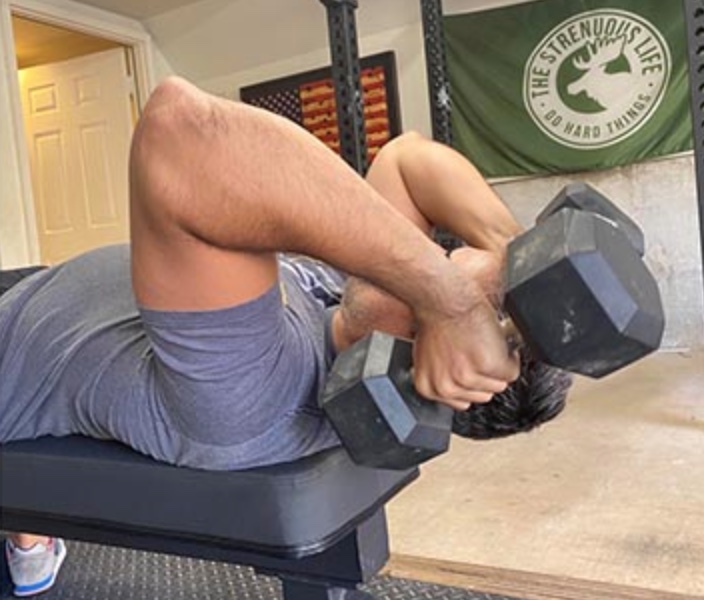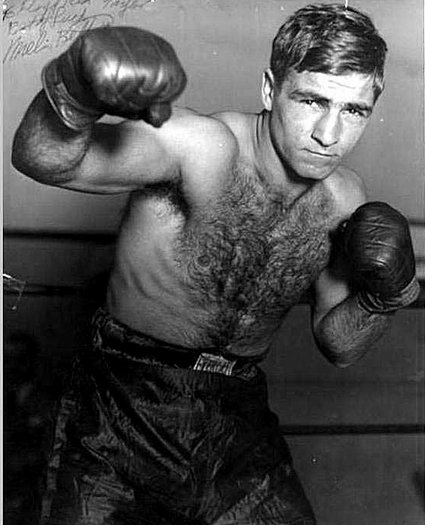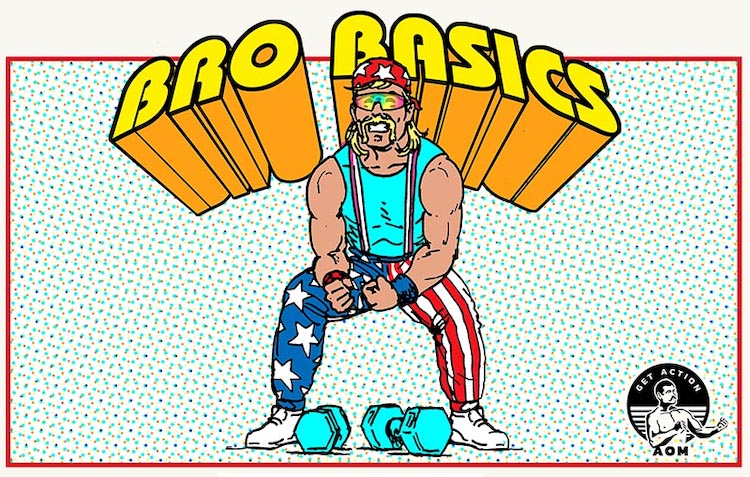
Welcome back to Bro Basics, a series that covers exercises that are popular and can be useful but are often done inadequately and solely for aesthetics and shows the exercises’ broader function and how to perform them correctly.
In our last edition of Bro Basics, we covered a popular back exercise done with a machine: the lat pulldown. Today we tackle another popular back exercise — this one done with free weights: the row.
For insights about how to perform the row, I turned to Barbell Logic strength coach, Nick Soleyn. Below we’ll get into his advice on why and how to incorporate the row into your workouts.
What Muscles Are Worked by the Row?
There are different variations of the row, and each one targets different muscle groups a little differently. But every type of row works the same basic muscles.
Similar to the lat pulldown, the primary muscle that the row engages is the latissimus dorsi. This is the broad, flat muscle that stretches across the back of your torso and goes under your arms. Your lats stabilize your shoulders, help with posture, allow you to swim and rock climb, and even assist in breathing.
The row also works the rhomboids, a muscle group responsible for maintaining good posture. Another group of back muscles the row strengthens is your spinal erectors, which run down the length of your spine. You use your spinal erectors to maintain a strong torso while performing the squat and deadlift and to keep you standing straight during your day-to-day life. Strong spinal erectors = fewer back pain problems.
The row also indirectly works your biceps, shoulders, and forearm muscles.
Why Do Rows?
Strengthens a common human movement. You do row movements in your daily life. Pulling the starter cord on the lawnmower, lifting heavy objects off the ground, opening heavy doors, and raking leaves are everyday movements that can be supported by the row.
Contributes directly to the main barbell lifts. If you’re serious about your barbell lifts, you need to do rows. Building a strong, broad back gives you a bigger “shelf” for the barbell when you squat. A stronger back can help you create a more prominent arch when you bench and have more stability when pressing weight overhead.
Most obviously, rows will help your deadlift. At some point, just deadlifting is not enough to continue building your back. Rows can be done with relatively heavy weights while targeting the back more directly than the deadlift. The row also helps improve grip strength which is vital on the deadlift.
Great alternative to pull-ups and lat pulldowns. Most strength programs include pull-ups because they work a wide range of back and upper body muscles. But to get the benefits of pull-ups, you need to be able to do at least five in a set. You’re not going to get stronger doing just one stinking pull-up.
When an athlete can’t complete multiple pull-up reps, a coach will often program lat pulldowns since they work the same muscles as pull-ups. But many people don’t have access to a lat pulldown machine. Wut do?
You do rows. That’s wut do.
You just need a barbell or some dumbbells. Heck, as we’ll see, you actually don’t even need any weights at all.
Aesthetics, brah! Want to make the ladies swoon and dudes respect you? Then you want a v-shaped torso: large chest, shoulder, and back muscles that taper down to a narrower waist. The row is a fantastic lift that can increase the size of your back (and even your shoulders), helping you develop that masculine v-shape.
How to Do the Row: Row Variations
The basic row movement is a pull toward your chest with good posture and a braced and stable core. The movement can be done with a barbell, dumbbells, or bodyweight. Below we highlight the most common row varieties for strength and sport.
Basic Barbell Row
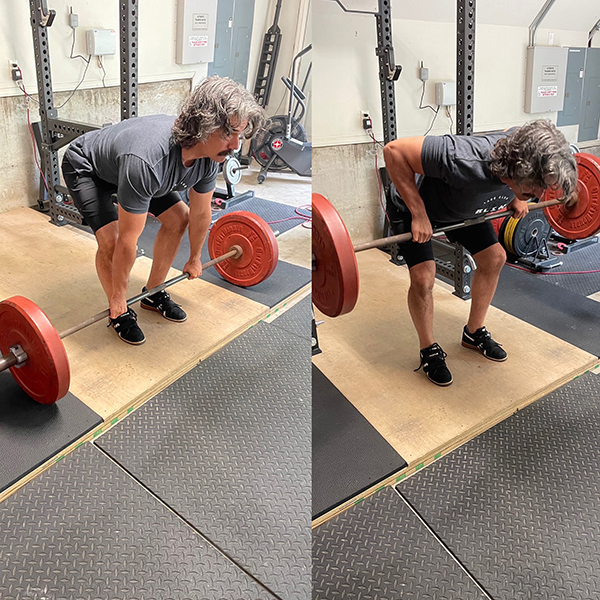
To perform the basic barbell row, stand so that the barbell is about an inch or two in front of the middle of your foot.
Bend over and grab the bar with a grip that’s slightly wider than the one you’d use on the deadlift.
Extend, or straighten, your back. Then use your arms to pull the barbell towards your upper abs. If you can’t hit your upper abs, the weight is too heavy.
Keeping your back straight, lower the barbell to the ground. That’s one rep. Repeat while keeping your back in extension.
The Pendlay Row
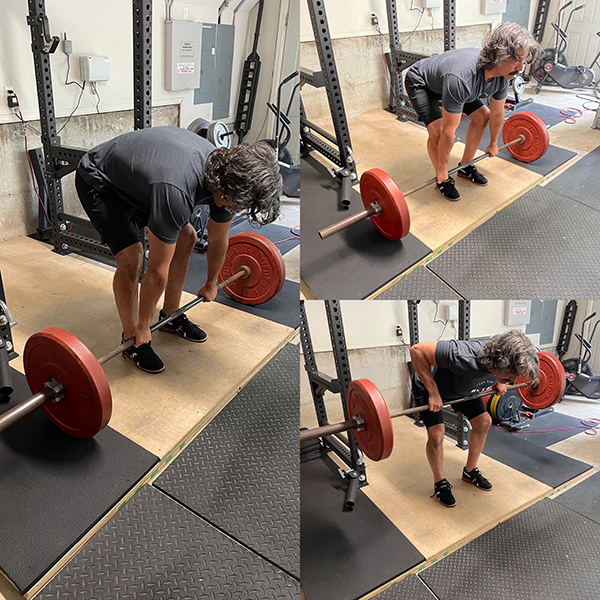
Named for the late weightlifting coach Glenn Pendlay, the Pendlay row is distinguished from the basic barbell row in this way: while the latter has you extend your back before you start the lift, the former has you extend it while you’re performing the lift. It’s a small difference, but setting your back at the same time you’re pulling the bar makes for a more explosive lift. Consequently, you’ll be able to pull more weight with the Pendlay row than with the basic barbell row. (The basic barbell row has its own upside in that it targets the lats more than the Pendlay does.)
To perform the Pendlay row, set up as in the basic barbell row, where the barbell is about an inch or two in front of the middle of your foot, and you’re gripping it with a grip that’s slightly wider than the one you’d use on the deadlift.
Your back should be in flexion, or rounded, before you start the lift.
Extend, or straighten, your back to start the lift. Extending the back starts the bar moving upward, creating momentum. At the same time you’re extending your back, use your arms to explosively pull the barbell towards your upper abs.
Lower the barbell to the ground. That’s one rep.
This is my favorite variation of the row. Its explosiveness makes it real satisfying to do.
Bodybuilder Barbell Row

If you’ve seen bros doing barbell rows at the gym, you’ve likely seen them doing bodybuilder rows.
To get into the starting position for the bodybuilder row, deadlift a barbell or a set of dumbbells until the weight(s) reaches just below your knees. You can let the bar hang out in front of you a few inches. Maintain a flat back. You should be angled at about a 45-degree angle from the hip.
Pull the bar towards your lower abs.
Lower the bar back down to just below your knee.
Maintaining the hang position and pulling the bar to the lower abs will work your lats more than the Pendlay and basic barbell row. Because the movement doesn’t begin and end on the floor like it does on those other variations, however, you’ll have to lower the weight on the bar when doing bodybuilder rows.
Basic One-Arm Dumbbell Row

When you do a one-arm dumbbell row, you must call upon more core stability as you resist the twisting pull of the weight. So not only are you working your lats, you’re also working your core. After the Pendlay row, this is my next favorite row variation. You can get a nice “pump” with the one-arm dumbbell row.
Ideally, you’ll have a bench for this lift. If you’re holding the dumbbell in your right hand, place your left knee on the bench. Lean forward and brace yourself on the bench with your left hand. Right foot is placed firmly on the floor with your right leg straight. Let your right arm holding the dumbbell hang down straight. Hold the dumbbell in a neutral grip. This is the starting position.
To perform the one-arm dumbbell row, pull the bell as high as you can without twisting toward the ceiling. Maintain an extended back throughout the lift. Lower the dumbbell back down in a steady and controlled manner. It should feel like you’re pulling the starter cord on a lawnmower.
After you complete the reps with your right arm, switch to your left arm.
Bodyweight Inverted Row
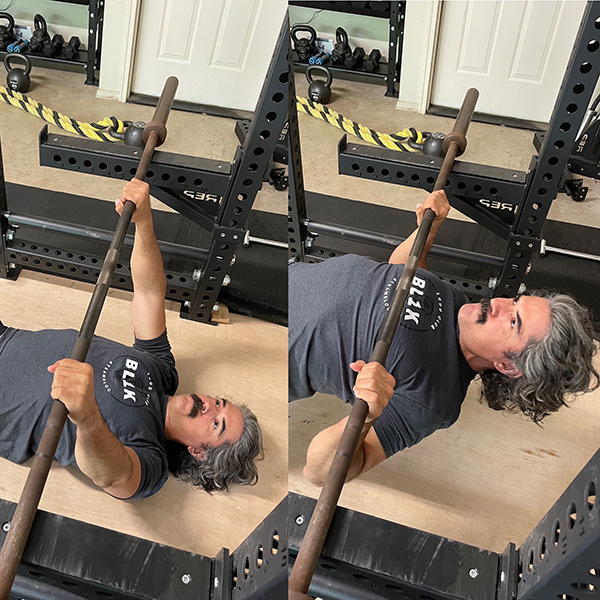
The inverted row is a great way to build pull-up strength if you can’t yet complete many (any) pull-ups. It’s adjustable to any level, and if you don’t have access to a gym/lifting rack, many public fitness “parks” offer a bar that can be used for this exercise.
To set up in a lifting rack: Place a barbell on safeties where you can grip it while lying flat on your back, with your arms fully outstretched. Lie down with shoulders directly under the barbell, legs extended, heels on the floor. Pull your clavicle or sternum to the bar. Pause at the top for extra work and lower yourself back down slowly.
To make these easier: put your feet flat on the floor and bend your knees. This allows you to use your legs for some assistance.
To make these harder: elevate your feet on a bench, stool, or box.
Programming the Row
The Pendlay row and basic barbell row act as supplemental lifts to the deadlift. You can do rows immediately after the deadlift or even replace them with the deadlift on some days. The coaches at Barbell Logic like to program heavy rows on lower body days, alternating deadlift days with row days. They prescribe an initial row regimen of 3 sets of 8. Over time, as you get better at the lift, add weight and reduce the reps until you are performing 3 heavy sets of 5 reps each.
Other row versions should be used as accessory lifts where your program benefits from extra back training. Bodybuilding rows, dumbbell rows, and other accessory rows tend to fit well at the end of your upper body days either by themselves or as part of a circuit. Typically, you’ll perform these rows for 3 to 5 sets of 8 to 12 reps. Strict form and higher repetitions will emphasize the back-building effects of these accessory movements.
Lately, I’ve been doing one-armed rows as part of a circuit after my upper-body workouts (bench and shoulder press). I’ve been doing 10-12 reps for each set.
Read the rest of the installments in the Bro Basics series:
Tags: Bro Basics, Exercises


